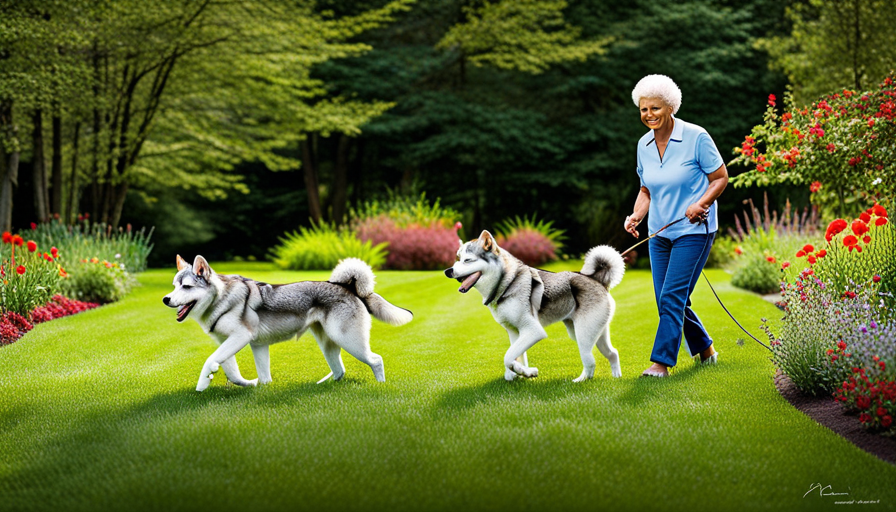How to Deal With an Aggressive Husky
Are you struggling to handle your aggressive husky? Dealing with an aggressive dog can be overwhelming, but don’t worry…

Are you struggling to handle your aggressive husky?
Dealing with an aggressive dog can be overwhelming, but don’t worry – there are effective strategies to help you navigate this challenging situation.
In this article, we will guide you through understanding aggression in huskies and identifying triggers and warning signs.
We’ll also teach you how to implement positive reinforcement techniques, establish boundaries, and find professional help when needed.
By the end, you’ll have the knowledge and tools necessary to create a harmonious relationship with your furry friend.
Key Takeaways
- Understanding the natural instinct for dominance in Huskies is crucial in dealing with aggression.
- Recognizing the triggers and warning signs of aggression, such as stress signals and changes in body language, is important for managing a Husky’s aggression.
- Implementing positive reinforcement training techniques, such as using treats and praise, can effectively manage aggression in Huskies.
- Establishing boundaries and consistency through reward-based discipline and clear expectations can help in dealing with an aggressive Husky.
Understanding Aggression in Huskies

Understanding aggression in huskies can be challenging, but it’s important to educate yourself on their behavior.
Huskies have a natural instinct for dominance, which can sometimes manifest as aggression towards other pets. This behavior stems from their ancestral history as sled dogs and their need to establish a hierarchy within a pack.
It’s crucial to socialize your husky from an early age and teach them proper obedience commands.
Additionally, aggression towards strangers is another aspect to consider. Huskies are known for being friendly and outgoing, but some may display protective or territorial behaviors when encountering unfamiliar people.
Proper training and positive reinforcement techniques can help manage this aggression and ensure your husky learns appropriate boundaries.
Identifying Triggers and Warning Signs
Spotting the triggers and warning signs is crucial when managing an assertive husky. Recognizing stress signals is key to preventing aggressive behavior.
Your husky may display certain behaviors when feeling stressed or anxious, such as growling, barking excessively, or showing their teeth. Pay attention to changes in body language like raised fur, stiff posture, or a lowered tail. These signs indicate that your husky is feeling threatened and may become aggressive if not addressed promptly.
It’s important to manage these situations by removing your dog from the trigger and providing a calm and secure environment. Avoid punishment or yelling as this can escalate the situation further. Instead, redirect their attention with toys or training exercises to help them relax and regain control of their emotions.
Implementing Positive Reinforcement Training Techniques

Implementing positive reinforcement training techniques can be an effective way to encourage desired behaviors in your assertive husky. By using reward-based training methods, you can create a positive and enjoyable learning experience for your furry friend. Here are three steps to help you build trust and bond with your Husky:
-
Use treats and praise: Reward your husky with treats or verbal praise when they exhibit the behavior you want to reinforce. This will motivate them to repeat the desired action.
-
Consistency is key: Be consistent in your training approach and use the same commands and rewards each time. This will help your husky understand what is expected of them.
-
Patience and understanding: Building trust takes time, so be patient with your husky during the training process. Understand that every dog learns at their own pace, and positive reinforcement will yield better results than punishment.
Establishing Boundaries and Consistency
Establishing boundaries and consistency is crucial when training your assertive husky. It helps them understand what behaviors are acceptable. Reward-based discipline is an effective approach to reinforce positive behaviors. By rewarding good behavior with treats, praise, or playtime, you can motivate your husky to repeat those desirable actions.
Setting clear expectations is also important. Your husky needs to know what is expected of them. Consistently using commands and cues will help them understand what you want them to do. It’s essential to be consistent in enforcing rules and boundaries every time. This way, your husky learns the appropriate behavior consistently.
With patience and consistency, you can establish a strong foundation for training your assertive husky. This will also help you build a loving and respectful relationship with them.
Seeking Professional Help and Support
If you’re struggling with training your assertive husky, seeking professional help and support can provide valuable guidance and expertise. Dealing with an aggressive husky can be challenging, but with the right approach, it is possible to rehabilitate their behavior and build trust.
Here are three reasons why professional help is beneficial:
-
Expertise in aggressive behavior rehabilitation: Professionals have experience dealing with aggression in dogs and can implement effective strategies to modify your husky’s behavior.
-
Individualized training plans: A professional will assess your husky’s specific needs and create a tailored training plan that addresses their aggression while considering their unique personality and circumstances.
-
Emotional support for both you and your dog: Dealing with an aggressive husky can be emotionally taxing. Professional trainers offer guidance, reassurance, and encouragement throughout the process, helping you stay motivated and confident.
Frequently Asked Questions
Can I Use Punishment or Physical Force to Control My Aggressive Husky?
You shouldn’t use punishment or physical force to control your aggressive husky. Instead, focus on using positive reinforcement and understanding the underlying causes of aggression in huskies for effective management.
Is Aggression in Huskies a Result of Their Breed or Genetics?
Aggression in huskies can be influenced by both breed and environment. While genetics may play a role, it is important to consider the impact of training techniques and socialization in managing aggression.
How Long Does It Usually Take to See Improvements in My Husky’s Aggressive Behavior?
Improvements in your husky’s aggressive behavior can vary, but with consistent training techniques for aggressive huskies, you may start seeing positive changes within a few weeks or months. Patience and consistency are key.
Can Neutering or Spaying My Husky Help Reduce Their Aggression?
Neutering or spaying your husky can help reduce aggression. However, it’s important to remember that training and socialization also play a crucial role in addressing aggressive behavior and ensuring a well-behaved dog.
Are There Any Alternative Therapies or Medications That Can Help Manage My Husky’s Aggression?
Using alternative therapies or natural remedies can help manage your husky’s aggression. Some options include behavioral training, aromatherapy, and herbal supplements. Consult with a professional to find the best approach for your dog.
Conclusion
In conclusion, dealing with an aggressive husky requires patience, understanding, and a commitment to positive reinforcement.
By identifying triggers and warning signs, implementing training techniques that focus on rewards rather than punishment, and establishing consistent boundaries, you can help your furry friend overcome their aggression.
Remember the power of love and consistency in shaping their behavior.
With dedication and support from professionals if needed, you can create a safe and harmonious environment for both you and your husky.





